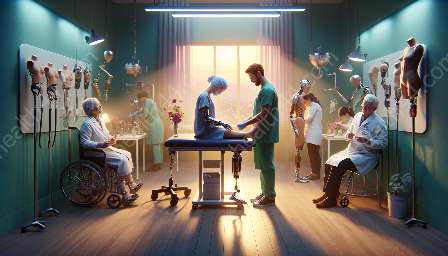When it comes to the healthcare industry, accurate diagnostics are crucial for patient care. Diagnostic equipment, such as blood pressure monitors, plays a vital role in monitoring the health status of individuals. Additionally, these diagnostic tools must be compatible with other medical devices and prosthetic devices to ensure seamless patient care and management. In this topic cluster, we will delve into the world of diagnostic equipment, its compatibility with prosthetic devices, and its integration with other medical devices and equipment.
The Role of Diagnostic Equipment in Healthcare
Diagnostic equipment encompasses a wide range of devices used to assess, diagnose, and monitor medical conditions. Blood pressure monitors, for instance, are essential in measuring a patient's blood pressure, providing vital information about their cardiovascular health. Furthermore, advancements in technology have led to the development of digital blood pressure monitors, which offer greater accuracy and ease of use.
Other diagnostic equipment includes devices for measuring temperature, heart rate, oxygen saturation, and more. These tools are indispensable in providing healthcare professionals with the information they need to make informed decisions regarding patient care and treatment plans. In the context of prosthetic devices, accurate diagnostic tools become even more critical to ensure the proper functioning and fit of the prosthetic.
Compatibility of Diagnostic Equipment with Prosthetic Devices
Prosthetic devices are designed to enhance the quality of life for individuals who have lost a limb. Whether it's a prosthetic arm, leg, or any other type of limb replacement, the compatibility of diagnostic equipment with these devices is crucial. For example, blood pressure monitors must be designed with user-friendly features that accommodate individuals using prosthetic limbs. Ergonomic designs and adjustable cuffs are important considerations for individuals with limb differences.
Furthermore, the integration of diagnostic equipment with prosthetic devices may involve the development of specialized accessories or interfaces that allow seamless use of diagnostic tools. This compatibility ensures that individuals with prosthetic devices can easily monitor their health without facing limitations due to their limb replacements.
Integration with Other Medical Devices and Equipment
In a healthcare setting, diagnostic equipment must seamlessly integrate with other medical devices and equipment to streamline patient care processes. Whether it's electronic health records systems, medical imaging devices, or even wearable medical technology, compatibility and interoperability are critical. For example, data captured by a blood pressure monitor must be effortlessly transferred to electronic health records for comprehensive patient monitoring.
Furthermore, as the healthcare industry advances, the concept of connected and interoperable medical devices becomes increasingly important. This interconnected ecosystem allows for real-time monitoring and collaboration among various healthcare professionals, ultimately benefiting patient outcomes.
The Future of Diagnostic Equipment and Prosthetic Devices
As technology continues to evolve, the future holds promising advancements in both diagnostic equipment and prosthetic devices. Innovations such as smart diagnostic tools that can seamlessly communicate with prosthetic devices are on the horizon. Imagine a blood pressure monitor that not only provides accurate readings but also syncs with a prosthetic limb to enhance the wearer's overall health management.
Moreover, the integration of artificial intelligence and machine learning algorithms into diagnostic equipment opens up possibilities for predictive and preventive healthcare measures. When combined with prosthetic technology, these advancements can significantly improve the lives of individuals with limb replacements, offering greater mobility and potential health benefits.
Conclusion
Diagnostic equipment, including blood pressure monitors, plays a crucial role in healthcare by providing essential health data. Compatibility with prosthetic devices and seamless integration with other medical equipment are vital considerations for fostering a holistic approach to patient care. As technology continues to advance, the collaborative development of diagnostic equipment and prosthetic devices holds the promise of improving the overall quality of life for individuals with limb replacements.


